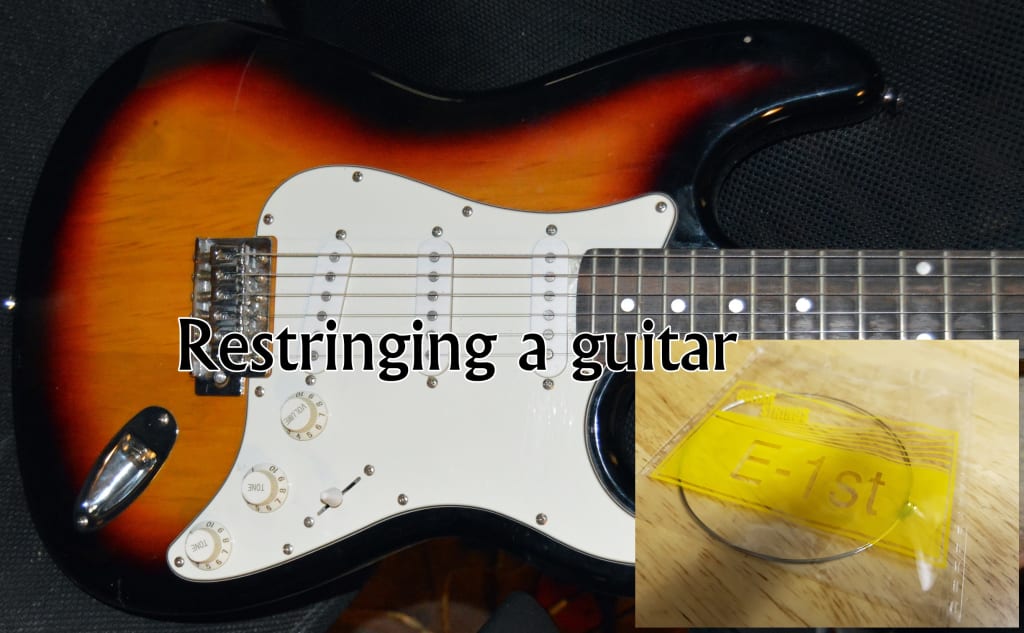
I never actually thought people wouldn't know how to restring a guitar, for me it was pretty obvious from day one how the strings went on an electric, an acoustic. I did have to be shown when it came to a classical guitar. It came to my attention recently that not everyone is as perceptive as I am, and I also had the added advantage of being interested in guitars long before I started learning to play one.
It never actually occurred to me that this may be something people struggle with, this was until I bought my 15yr old son his first electric guitar and he snapped a string, my son has Autism and this makes him feel very frustrated when he cannot do something or if he finds something difficult to understand.
Unfortunately I live 50 miles away from him and the most contact we get when it isn't possible for me to get over to see him in person is via Skype, so as you can imagine I wasn't able to put a new string on for him. Then the Covid 19 pandemic began which made it impossible for me to go and visit, so for around 5 or 6 months I have been trying to coax him into putting the string on by himself.
I bought him a new string and had it sent to his mums address, it arrived and he attempted to put it on, he didn't do as I had asked and wait until I could tell him how. He went ahead and attempted it himself, all well and good except he did it how he thought it should go and not how it actually should be installed.
He placed the ball of the string directly beneath the saddle and trying to tune it had the affect of breaking the string, to those who play a guitar this is an obvious mistake but to someone who has little knowledge of the instrument probably quite a simple mistake to make.
I bought him another string and again sent it straight there, this time telling him he wouldn't get another if he didn't watch videos on how to do it and let me talk him through it, he did as I requested after weeks of refusal to even attempt it, the video seemed to confused him even more so I decided to devise a short series of picture tutorials in the hope it would make more sense.
To my delight and after a little bit of fiddling about trying to get the string through the bridge he succeeded, the look on his face when he realized he had done it by himself was worth the tantrums and refusals we had gone through and the feeling of accomplishment was evident in his expression.
So with this in mind I thought it may be a good idea to share this process with others who struggle to restring their guitar. There are so many guitars bought and then thrown to one side to gather dust all because a string has snapped (usually the Top E, thinnest string or the 3rd G string) and then eventually sold on through lack of use when all that was required was a simple process to put a new string on.
Of course tuning a guitar is a whole different matter and something I will get into another time, for now let us concentrate on putting a single string on a standard right handed Stratocaster type guitar. Bridges may vary on other guitars and as such this is purely a guide for those with a basic tremolo block, Stratocaster style bridge.
See the diagram below if you are unsure what a Bridge is when used as a term to describe a guitar part. You should learn what each part of your instrument is called and what it is for, this will help in future dilemma's should you need to repair any part of your guitar and helps to understand your instrument which is required to play it.
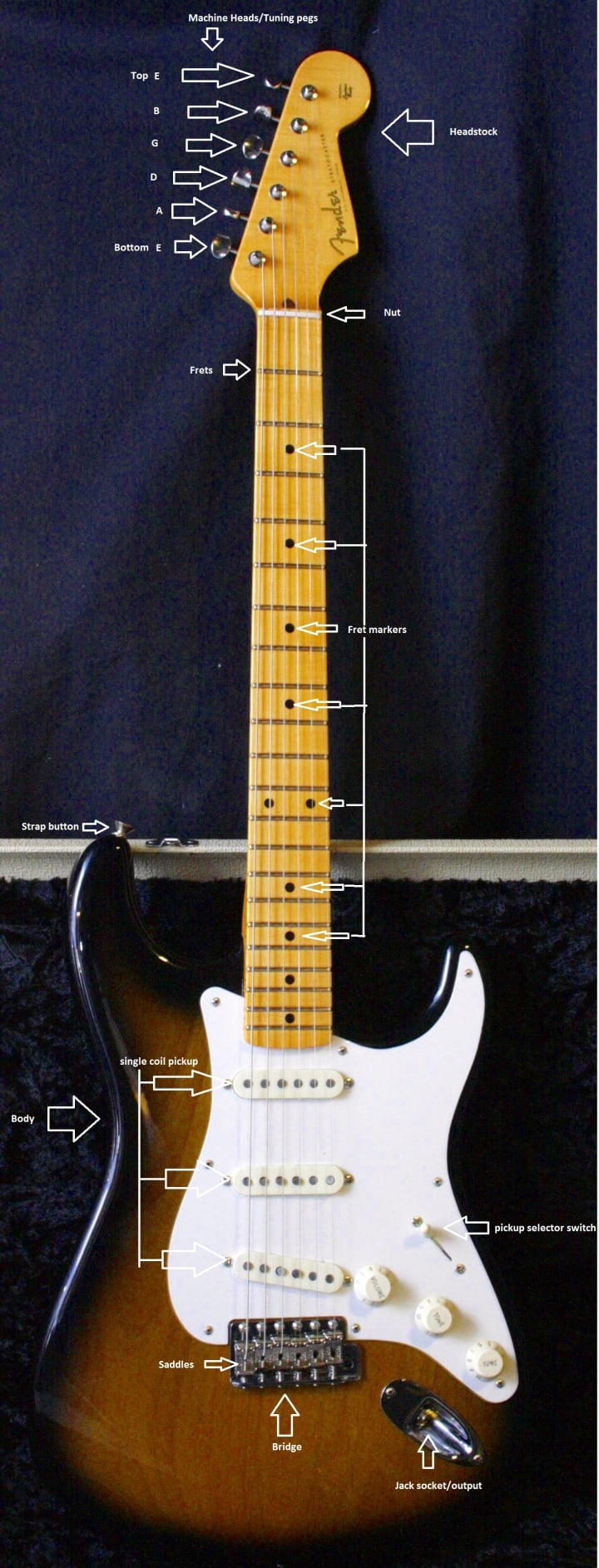
The first thing you should do is find a flat surface such as a table and lay a soft towel over it, place your guitar on top of the towel with the strings upward to begin with. If you have a neck support for your guitar now is the time to use it, alternatively you could use a cushion placed just below the nut beneath the neck to raise it slightly.
Now we remove the old broken string, this can sometimes be relatively difficult if it has been stuck on the guitar for some time, push the remainder of the string through the saddle, it should come out at the back of the guitar where the plastic cover is for the tremolo block.
NB: the tremolo block is located beneath the bridge and is covered by a plastic cover which can be removed by undoing the screws holding it in place, this is not required to change strings but may make things a little easier for you if you remove the cover.
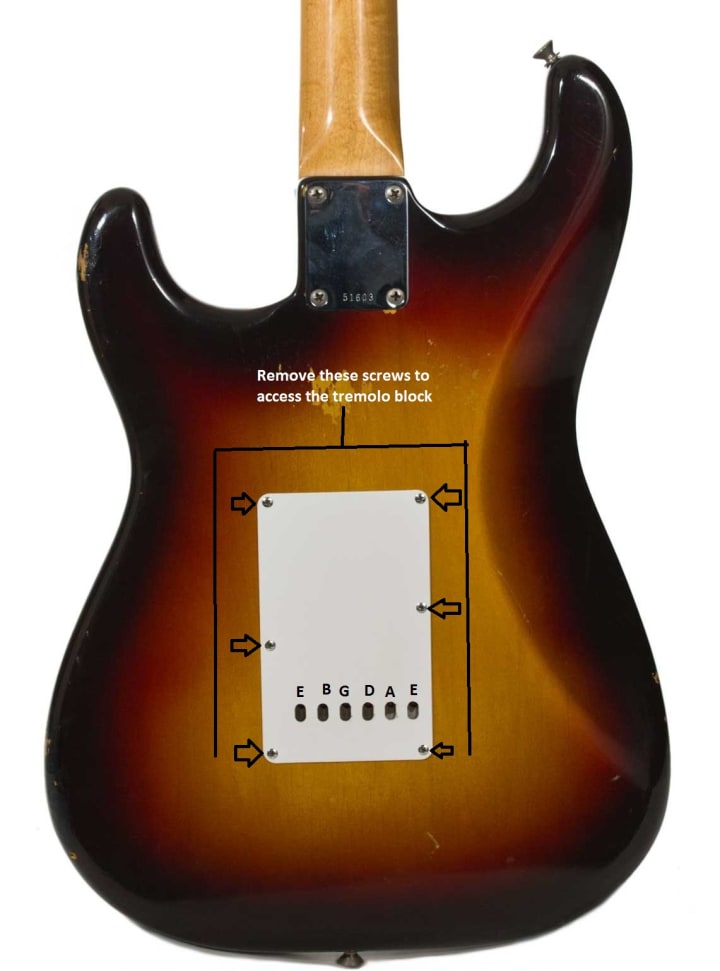
If the string will not come out and the ball end is stuck then I find using a very thin screwdriver (jewelers screwdriver) a skewer or something slim enough to fit down the hole between the saddle and the string, a little force should push the ball of the string out enough to remove it.
Now we move on to the machine head for the string, in this instance we will be changing the thinnest string which is the Top E string. On a right handed Stratocaster style guitar the machine head for tuning the Top E is located at the top of the headstock. Remove any excess string left attached to the machine head, if you have difficulty doing this by hand, use a pair of thin nosed pliers or teasers to ease the remaining string out, now turn the machine head so that the holes n the pin are vertical and in alignment with the other strings.
Make sure to dispose of your old strings correctly by wrapping them up and putting them in a bin, next turn the guitar over so it is laying on its front and take your new string, it should be a simple process to unravel it but take care not to get any kinks in the string.
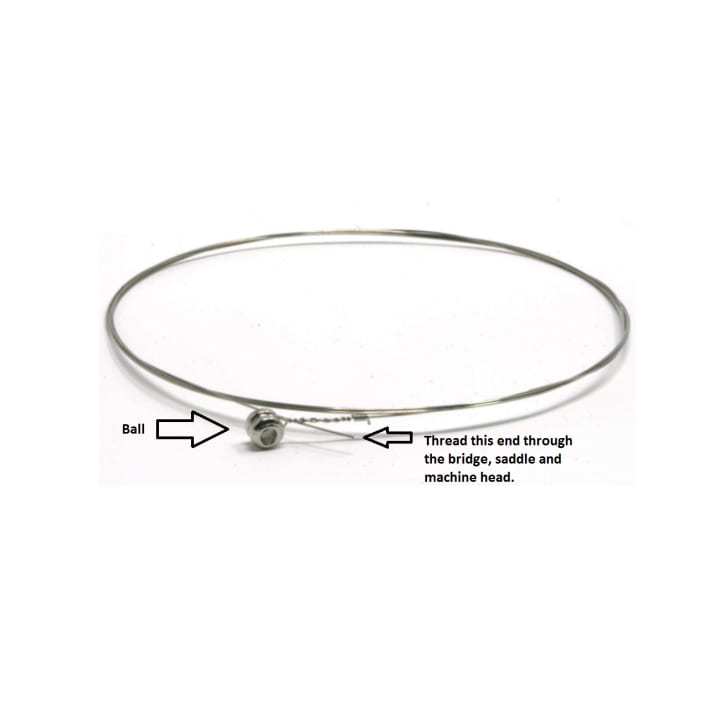
Take the end that doesn't have a brass ball (metal piece) attached, and push it into the hole on the left side of the guitar (standing at the bottom and looking towards the top of the headstock from the body). This may take a few attempts but you should be able to push the string straight through the saddle on the opposite side (see pic below).
Once you have the string through the saddle pull it until the ball end is embedded into the bridge block. You should feel some resistance and not be able to pull it any further. Once you feel the resistance its time to thread the string through the machine head.
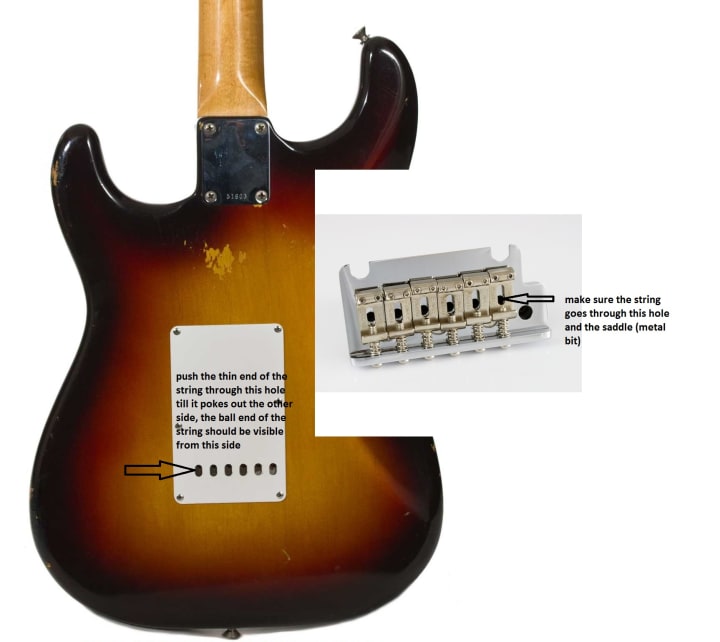
Following the direction up the neck and away from the guitar body, push the string into the hole on the machine head and pull it through. Keep a tight hold of it and pull it as taught as you can, I find using pliers helps to hold the end of the string while turning the machine head several times until the string is tight enough to be played without a buzzing noise hitting the frets.
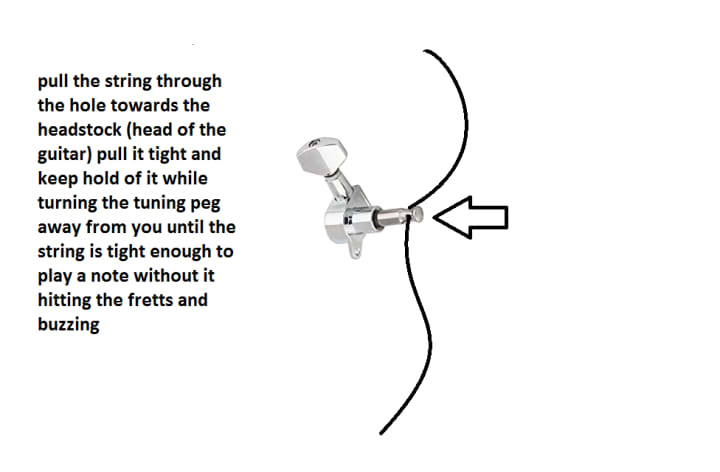
Make sure that the string is sitting in the groove of the nut and is underneath any string tree if fitted, after each couple of turns play the string, if the string is hitting the frets you will hear a buzzing noise, repeat this process until playing the strings gives you a clear note.
A string tree is a small piece of metal screwed into the headstock with grooves to hold two or more strings in place, not all guitars have these.
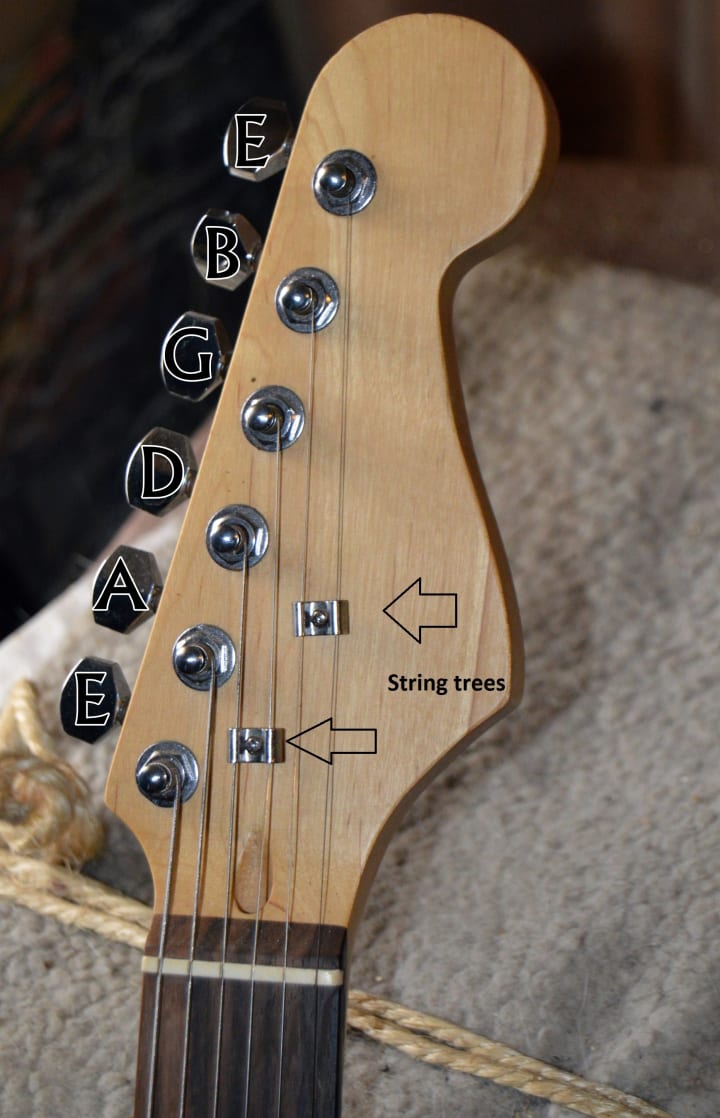
You can repeat the whole of the above process with other strings as required just follow the instructions and substitute the correct string hole on the bridge to the correct machine head as can be seen in the images below. For some other styles of bridges its a similar process of going through the back of the body.
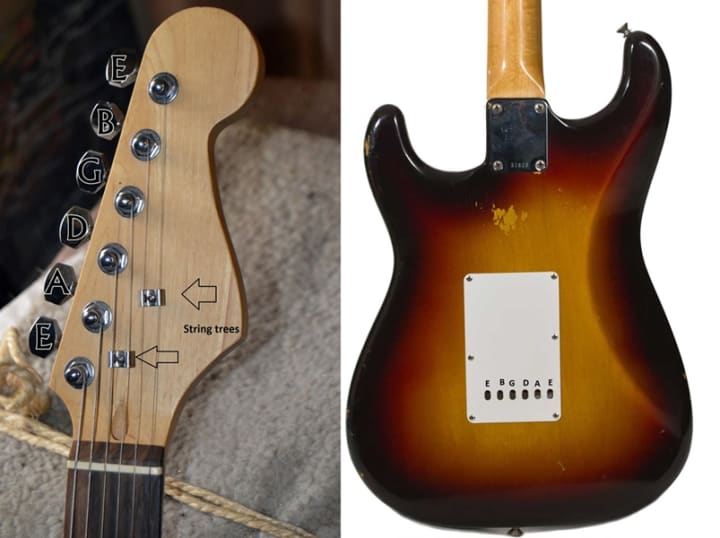
There are of course exceptions to this such as Floyd Rose systems, classical guitars and acoustic guitars which are all strung differently and I may cover some of these in future articles although I will admit that I struggle with Floyd Rose myself and these do seem to be the most complicated of guitar bridges to restring.
In the meantime I hope this article helps you to get back into playing your guitar and serves as a tutorial for those who don't feel they have the confidence to attempt it, if you enjoyed this article please visit my profile by clicking on my name below and check out some of my other work on a variety of subjects, and if you happen to feel generous perhaps consider sending a tip by pressing the TIP button below.
About the Creator
Phill Ross
I have been writing for 39 years starting out with poetry then moved on to song lyrics and music/band reviews,I now write mostly historical related books and I have written and self published 15 books to date.






Comments
There are no comments for this story
Be the first to respond and start the conversation.